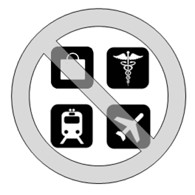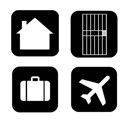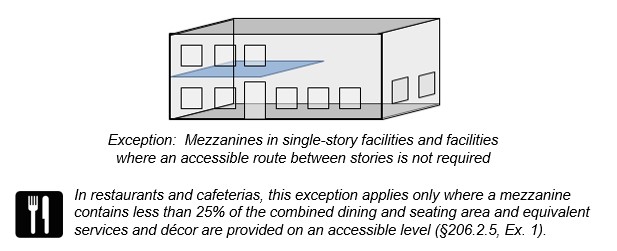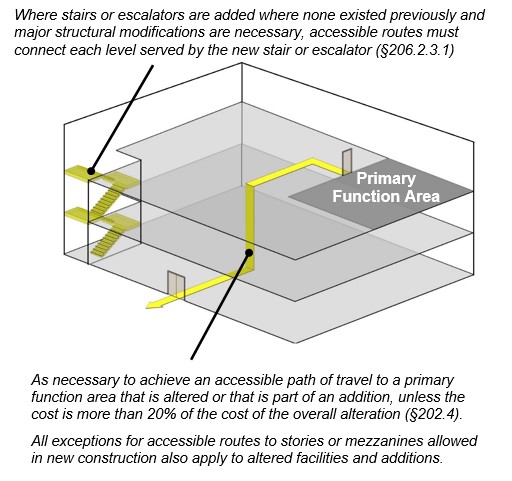Where Required: Multi-Story Buildings and Facilities [§206.2.3]
An accessible route must connect each story and mezzanine in a facility unless an exception applies. However, if a building does qualify for an exception in the Standards:
-
all other provisions in the Standards still apply to stories and mezzanines not served by an accessible route
-
elevators provided anyway must fully comply (as standard or LULA elevators)
-
vertical access still may be required by an applicable state or local code.
Private Sector Facilities (Places of Public Accommodation & Commercial Facilities)
An accessible route is not required to connect stories in a private sector facility (place of public accommodation or commercial facility subject to title III of the ADA) that is either less than 3 stories or that has under 3,000 square feet per story and is not a:
-
shopping center or mall with 5 or more sales or rental establishments
-
professional office of a health care provider
-
public transit facility or airport terminal
In mixed use facilities that otherwise qualify for this exception, vertical access is required to any story containing occupancies not permitted the exception.
Public Sector (Government) Facilities
An accessible route between stories is required in multi-story government facilities subject to title II of the ADA except those with no more than two stories where the inaccessible story above (or below) the entry level has no public use space and an occupant load of five maximum.
Exceptions for Specific Occupancies [§206.2.3]
The Standards also include limited exceptions for accessible routes between stories in air traffic control towers and, under certain conditions, detention and correctional facilities, residential facilities, multi-story transient lodging guest rooms, and qualified historic facilities.
Mezzanines (Private and Public Sector Facilities) [§206.2.4, Ex. 3]
An accessible route must serve mezzanines in multi-story facilities where vertical access between stories is required or provided. An accessible route to mezzanines is not required in:
-
single story facilities (mezzanines do not count as a story) or
-
facilities that are exempt from the requirement for an accessible route between stories (additional conditions apply to restaurants and cafeterias).
Alterations and Additions [§206.2.3.1, §202.4]
In alterations and additions to multi-story facilities, an accessible route to stories and mezzanines is required where a stair or escalator is provided where none existed previously and major structural modifications are necessary (§206.2.3.1). The accessible route must connect each level served by the new stair or escalator (except where a compliant connecting accessible route already exists).
An accessible route to stories or mezzanines may be required as part of an accessible path of travel to primary function areas that are altered or added (§202.4). Alterations or additions involving primary function areas must include an accessible path of travel that extends to site arrival points to the extent that the cost is not “disproportionate” (i.e., more than 20% of the total cost of alterations to the primary function area).
Exceptions for accessible routes between stories and to mezzanines permitted in new construction, including those based on the number of stories or square footage per story, apply fully to alterations and additions, including those that trigger an accessible path of travel to a primary function area.









User Comments/Questions
Add Comment/Question